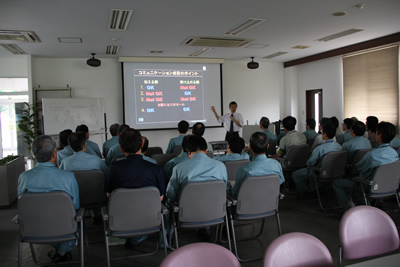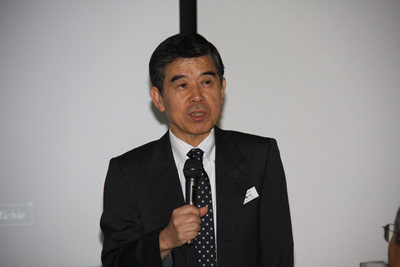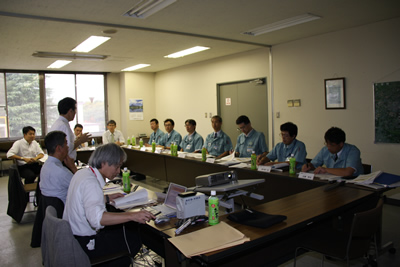|
|
 |
The 113th Safety Caravan was held at the Technical Center of Energy, Catalysts & Construction Materials Division, Sumitomo Metal Mining Co., Ltd. in Tokai-mura, Ibaraki Prefecture, on September 18, 2009. |
| Safety Presentation |

|
|
During the Safety Presentation
|
Thirty employees of the Technical Center of Energy, Catalysts & Construction Materials Division, Sumitomo Metal Mining Co., Ltd. and employees from affiliated companies attended the session.
Mr. Keiichi Hayashi, general manager of the Energy, Catalysts & Construction Materials Division Technical Center, gave the opening address prior to the main presentation.
“As I’m sure you are all aware, it is a daily concern for us how best to continue to keep our plant’s environment safe and upbeat.
Our main task is to operate and maintain our facility for its future disposal, and part of this task is to maintain a high level of motivation in the workplace.
As we grow older, the way we view and carry out our daily work changes from our younger days. How we manage our thinking and emotions will be very important in order to continue working safely and efficiently over the next 10 to 20 years as the plant faces retirement.
Given our situation, I had several discussions with the staff at the NS Net Division about what kind of material would be most relevant to us for this fourth Safety Caravan at our technical center. As a result of these discussions I was introduced to Professor Yoshida from Kumamoto University, who has kindly agreed to give a presentation today on ‘Workplace Safety and Motivation: The social psychology behind the desire to work.
This presentation will be of great interest to us all, so please give your attention to Professor Yoshida and consider how to apply his ideas in your daily work.”
After the opening address, Professor Michio Yoshida from Kumamoto University gave a presentation entitled “Workplace Safety and Motivation: The social psychology behind the desire to work.” |
| Summary
of presentation |

|
|
During the Safety Presentation
|
◆My field of research is group dynamics, which thinks about human behavior through connections with groups. Group dynamics can be generally thought of as being quite similar to social psychology. We humans live in groups from our birth to our death, and we are constantly involved with and connected to groups. It’s important to fully appreciate this point before trying to understand people.
◆Not so long ago, I spent a few days at a conference in Oslo, Norway. One thing I noticed was the number of people smoking and littering while out in the streets. In Norway, it is illegal to smoke inside public buildings. I presume this is why so many people smoke outside buildings and in the streets. We humans tend to follow rules and regulations where they exist in order to avoid the associated penalties. On the other hand, unless we are rebuked or censured for our behavior, we will continue to act in undesirable ways. In other words, a mindset, or a sense of ethics, is indispensible. In Japan, too, smoking in the streets has been banned and non-smoking cars on trains have been introduced, and today almost no one smokes in these places. It took a considerable amount of time, however, for this behavior to become the natural behavior. It’s apparent, then, that changing people’s habitual behaviors is no simple matter. From this example, we can see the necessity of both patience and persistence when providing encouragement and motivation to change. If this can be pursued successfully, it is possible to suddenly realize one day that the situation has indeed changed.
◆What initiatives can be taken when an organization is set to close in 10 or 20 years? One possibility is to become a model that others point to as an organization that arranged its affairs and its shutdown in an exemplary way. My hope for such an organization is that it would proactively set a goal of making its crowning achievement, the management of hisutorical demise.
◆Communicating an idea from one person to another is a difficult process. For a start, we ought to consider words as extremely vague and abstract entities.
For example, the images that even words called "the dog" remember actually are different by a person.
This is why it is crucial for both persons in conversation to confirm the exact meaning of their words. Secondly, we must be careful to never delude ourselves that our message has gotten through to the other person without verification. And in any regard, imposing what you believe to be common sense on another person is never the path to good communications. Human relationships are another key factor in determining communication outcomes. If a good relationship can be forged between the persons, communications will fall into place even with only partial information. On the other hand, if you have a dysfunctional relationship, your message will not get through no matter how complete the information is.
◆The raison d’être of one’s life and work is largely shaped by one’s outlook on things. One viewpoint I think is particularly important is that “the great is contained in the small.” For example, in personal relations, recognizing and evaluating the small things together generates a large amount of mutual trust. Another important quality is the “capability to self satisfy” that enables you to find satisfaction in your work. By fostering the ability that allows everyone to look at issues positively and the ability to give meaning to one’s own actions and find satisfaction in the fruits of those actions, it is possible to elevate the morale for the work, and in the process contribute to the organization’s overall safety.
Comments from the questionnaires conducted after the presentation:
●Thank you very much for the delightful presentation on how to maintain motivation in the workplace and how to communicate better. I appreciated that the speaker tailored the presentation to our plant’s situation.
●I will try to work on recognizing the small details in my communications with others.
●I found the explanation of how to maintain awareness in de-motivating circumstances very interesting and relevant.
●The professor’s examples in today’s presentation of how we can live from this point on were perfectly selected and very edifying. I hope to put these ideas into practice in the near future.
●I learned that one’s approach to things is crucial and influences one’s mood and that one’s way of thinking is important because it is tied to motivation.
●The professor gave a perspicuous description of how to discover value and rewarding from within your daily work and life drawing on his own experiences. This was the first time for me to encounter the “capability to self satisfy” concept, but I was very impressed by it. I’ll definitely work on my capability to self satisfy in order to find more rewarding and satisfaction in my current work. |
Safety information exchange session |

|
|
During the Safety information exchange session
|
At Sumitomo Metal Mining’s request, Professor Yoshida and JANTI staff exchanged ideas and opinions with the managerial class employees on the topic of “What does safety culture mean in the context of a small organization managing a nuclear power facility?” |
|
|







